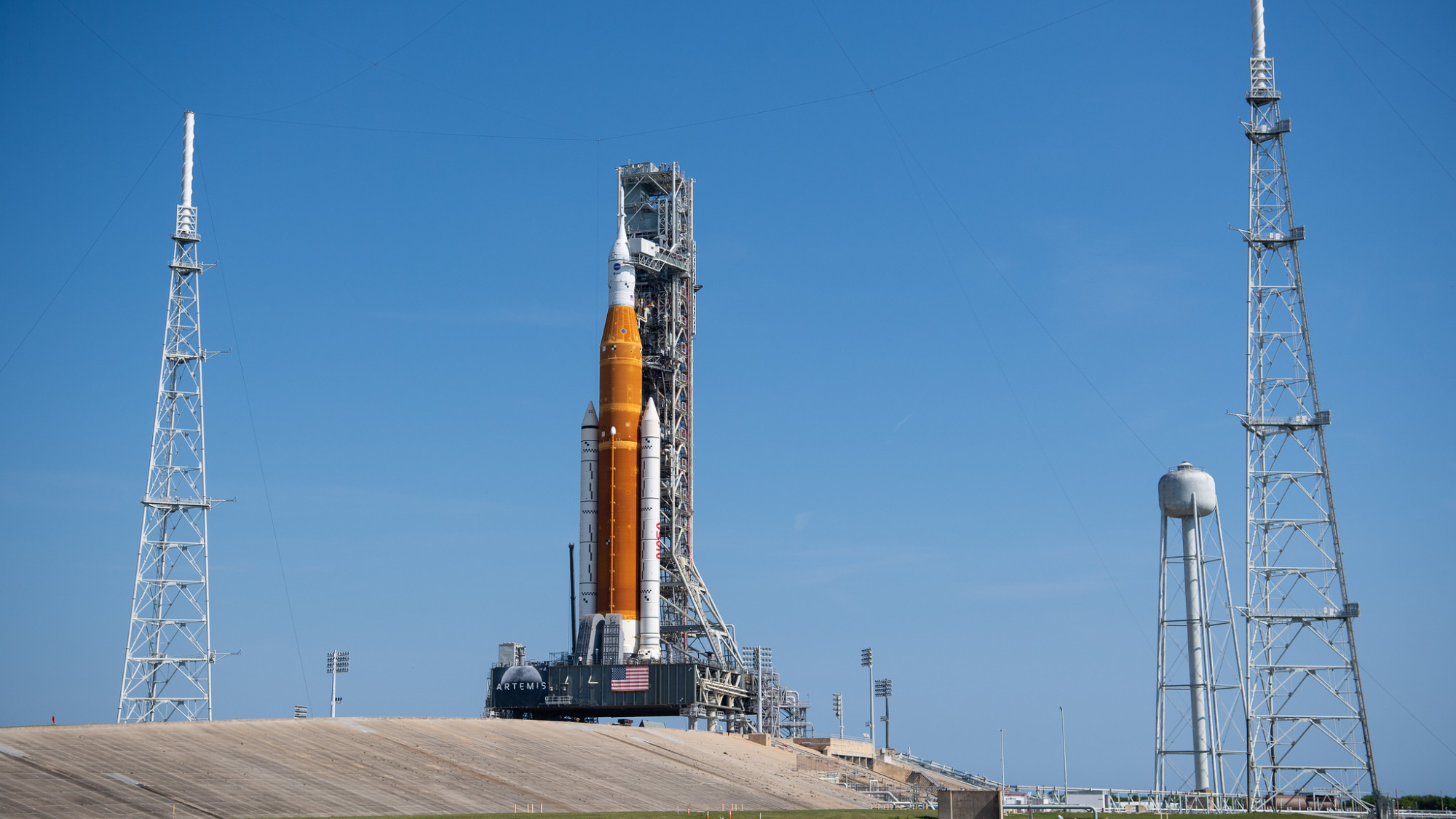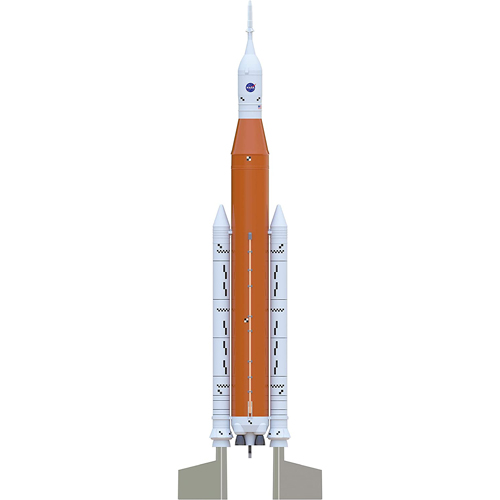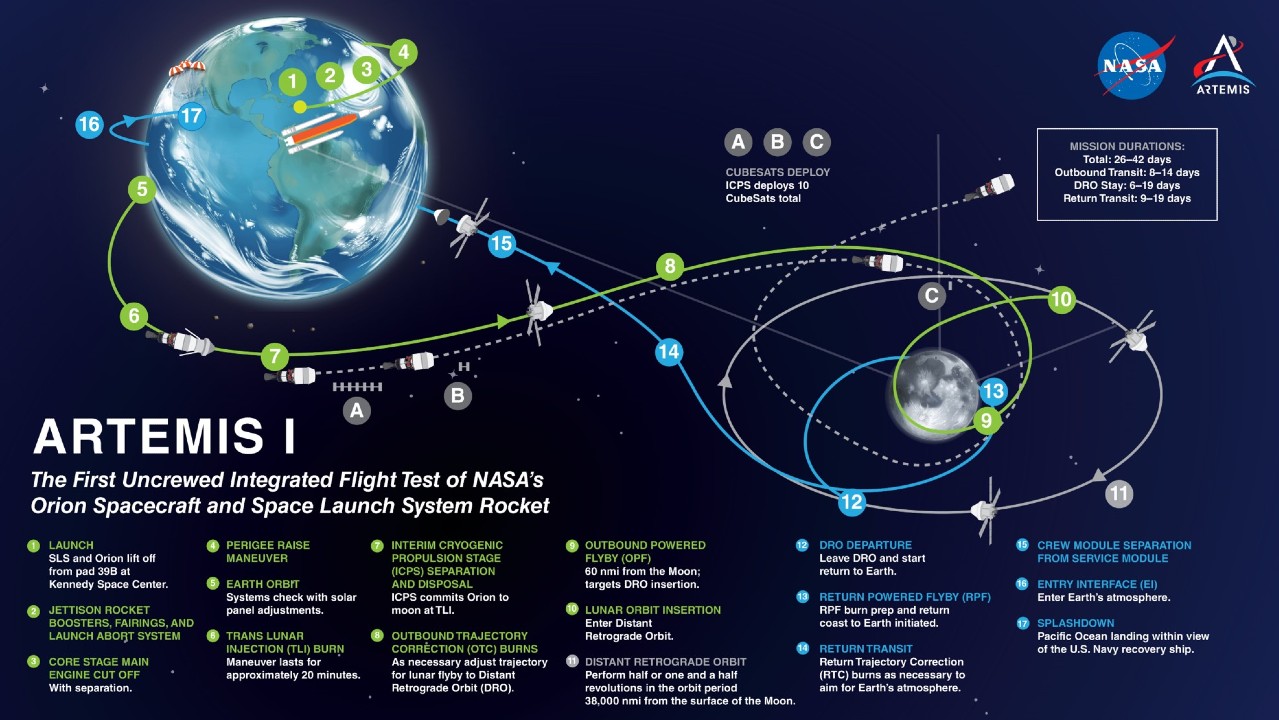NASA's Artemis 1 moon mission is 'go' for Aug. 29 launch
The Artemis 1 mission will use a Space Launch System megarocket to launch an Orion spacecraft to the moon.

NASA's first Artemis mission to the moon is "go" for launch.
The space agency on Monday (Aug. 22) cleared its Artemis 1 mission to launch an uncrewed test flight around the moon next week. Liftoff is scheduled for Monday, Aug. 29, during a two-hour window that opens at 8:33 a.m. EDT (1233 GMT).
The historic mission, the first of NASA's Artemis program that aims to return astronauts to the moon, will lift off from Pad 36B at the Kennedy Space Center in Florida. It will be the first flight of Space Launch System (SLS) megarocket, NASA's most powerful rocket ever, and a critical test of its Orion spacecraft.
"We are go for launch, which is absolutely outstanding," NASA associate administrator Robert Cabana told reporters in a press conference Monday night. "This day has been a long time coming."
Related: NASA's Artemis 1 moon mission: Live updates

You can launch a Space Launch System of your own with this Estes NASA SLS model rocket for a 1:200 scale version of NASA's moon megarocket. Read more about it.
Artemis 1 will launch an 322-foot (98 meters) SLS megarocket and its Orion capsule on a 42-day mission to circle the moon and return to Earth. NASA is billing the test flight as its first mission back to the moon with a crew-capable spacecraft in nearly 50 years. It's also NASA's first new vehicle of its own since the agency retired its space shuttle fleet over a decade ago.
According to NASA's plan, Artemis 1 will lift off from Pad 39B — the same launch pad used by the Apollo 10 mission to orbit the moon in 1969, as well as Skylab and Apollo-Soyuz missions — and take about a week to reach lunar orbit. It will stay there for about a month before returning to Earth on Oct. 10.
Get the Space.com Newsletter
Breaking space news, the latest updates on rocket launches, skywatching events and more!
That assumes everything will go perfectly with the flight. NASA has made it clear that things can go wrong.
"This is the first flight of a new rocket and a new spacecraft," Jim Free, NASA's Associate Administrator for Exploration Systems Development, told reporters. "We're doing something that is incredibly difficult to do and does carry inherent risk in it."
Related: NASA's Artemis 1 moon mission explained in photos

Mission managers said Monday that they intend to push the four-person Orion spacecraft hard, going beyond parameters the agency has set for crewed flights, to ensure the spacecraft gets put through its paces.
The mission's marathon 42-day length is longer than the standard 10-day or so Artemis crewed flights NASA has planned. That will give NASA and the European Space Agency, which built Orion's service module, time identify any issues to address for the first crewed flight. Orion is also carrying a "Moonikin" mannequin and humanoid torsos covered with sensors to measure the effects of vibration and space radiation on the human body, while 10 small cubesats will be deployed from the SLS during the flight to test new Artemis exploration technologies.
"We are pushing the vehicle to its limits, really stressing it to get ready for crew," Free said.
That crewed flight is Artemis 2, which NASA hopes to fly in 2024. Artemis 3, the first Artemis moon landing with a crew, is targeted for 2025 and will use a SpaceX Starship lander to fly astronauts to one of 13 candidate sites at the moon's south pole. But both those missions, of course, depend on how Artemis 1 turns out.
Related: Why we're always so entranced by the moon
NASA currently has three chances to launch Artemis 1 in its current flight window, which opens on Aug. 29. The backup days are Sept. 2 and Sept. 5, with NASA expected to outline its launch strategy later this week on Saturday (Aug. 27) after a Launch Readiness Review meeting.
There's still some work to do on the SLS rocket before it will be ready to flight.
NASA launch test director Charlie Blackwell-Thompson said launch crews have two final close-out tests to work through, one on the rocket's twin solid rocket boosters (larger versions of the ones used on NASA shuttles) and another on the connections between the SLS rocket and its mobile launch platform. The team does have one critical test to verify a fix to a leak spotted in a June fueling test during a kickstart phase to prepare the rocket's engines for its super-chilled propellant. That test can only be performed on launch day.
"That is something that we're going to demonstrate in the end for the first time on the day of launch, and if we do not successfully demonstrate that we are not going to launch that day," NASA Artemis 1 mission manager Mike Sarafin said.
Correction: An earlier version of this article misattributed a quote on the inherent risk of the Artemis 1 mission. It was Jim Free, NASA associate administrator for exploration systems development.
Email Tariq Malik at tmalik@space.com or follow him @tariqjmalik. Follow us @Spacedotcom, Facebook and Instagram.
Join our Space Forums to keep talking space on the latest missions, night sky and more! And if you have a news tip, correction or comment, let us know at: community@space.com.

Tariq is the Editor-in-Chief of Space.com and joined the team in 2001, first as an intern and staff writer, and later as an editor. He covers human spaceflight, exploration and space science, as well as skywatching and entertainment. He became Space.com's Managing Editor in 2009 and Editor-in-Chief in 2019. Before joining Space.com, Tariq was a staff reporter for The Los Angeles Times covering education and city beats in La Habra, Fullerton and Huntington Beach. In October 2022, Tariq received the Harry Kolcum Award for excellence in space reporting from the National Space Club Florida Committee. He is also an Eagle Scout (yes, he has the Space Exploration merit badge) and went to Space Camp four times as a kid and a fifth time as an adult. He has journalism degrees from the University of Southern California and New York University. You can find Tariq at Space.com and as the co-host to the This Week In Space podcast with space historian Rod Pyle on the TWiT network. To see his latest project, you can follow Tariq on Twitter @tariqjmalik.









